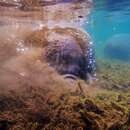Biology
(
англиски
)
добавил Arkive
These aquatic animals may live for over 50 years and exhibit a slow reproduction rate; they reach sexual maturity at three to five years old and at most they produce a single calf every two years. Pregnancy lasts for 11 to 14 months and the calf remains dependent on its mother for up to two years (5) (9). There is no distinct breeding season but when a female is receptive, many males may surround her in a mating herd and she will often mate with more than one male (6).
Manatees mainly feed on aquatic vegetation and can consume ten to fifteen percent of their body weight a day (6). Manatees in North America carry out seasonal migrations. They move to natural and industrial warm water sources in central and southern Florida in the winter, but can be found as far north as Virginia and the Carolinas when temperatures increase in the summer (6). Sirenians (manatees and dugongs) produce a large volume of gas, which is given off during the digestion of plant material and this makes them particularly buoyant, so much so that their bones are dense in order to compensate (10).
Conservation
(
англиски
)
добавил Arkive
West Indian manatees are protected by law in the United States and a Manatee Recovery Plan has been established in an effort to prevent the decline in this species (9). There are specific boat speed zones to prevent watercraft collisions and an ongoing research programme (6). Internationally, a number of organisations are involved in extensive research into manatee populations including surveys, tagging programmes and habitat assessment. This data will be vital for the introduction of successful management schemes to safeguard the future of this species.
Description
(
англиски
)
добавил Arkive
Possibly mistaken for mermaids by Christopher Columbus on a voyage to America, the West Indian manatee is a large, rotund, aquatic mammal. The tough skin is grey-brown with sparse hairs covering the body and many bristles on the muzzle (5). The front limbs are short flippers and the body tapers to a flat, paddle-shaped tail that distinguishes this species from the related dugong (Dugong dugon), which posses a fluke-like tail (6). Two subspecies of the West Indian manatee exist; the Florida manatee (Trichechus manatus latirostris) is usually larger in size than the Antillean manatee (T. m. manatus) (7). A unique feature (amongst mammals) of the manatee is the constant replacement of molar teeth; new teeth enter at the back of the jaw and replace old and worn teeth at the front (5). Recent evidence suggests that manatees may possess a unique sixth sense that enables them to detect pressure changes through sensory hairs (8).
Habitat
(
англиски
)
добавил Arkive
The West Indian manatee inhabits freshwater, estuarine, and marine waters, where it can be found in near-shore waters, canals, rivers, estuaries and saltwater bays (2) (6). Antillean manatees tend to be found further from the shore than their Florida relatives, and distribution and local use patterns throughout the range are influenced by access to freshwater areas, which are used for drinking (7).
Range
(
англиски
)
добавил Arkive
The West Indian manatee has a wide distribution, from the mid-Atlantic region of the United States, throughout the Caribbean Sea and Gulf of Mexico, south to coastal parts of northeastern and central-eastern South America. The Florida manatee subspecies occurs from eastern Texas to Virginia in the summer, but occupies waters of Florida and southeastern Georgia all year-round. The Antillean manatee occupies the remainder of the species range, from southwestern Texas to South America, but does not have a continuous distribution (2).
Status
(
англиски
)
добавил Arkive
Classified as Vulnerable (VU) on the IUCN Red List 2007 (1). Listed on Appendix I of CITES (3) and Appendix I of the Convention on Migratory Species (CMS or Bonn Convention) (4). Subspecies: Florida manatee (T. m. latirostris) classified as Endangered (EN), Antillean manatee (T. m. manatus) classified as Endangered (EN) (1).
Threats
(
англиски
)
добавил Arkive
Dugongs and manatees have been extensively hunted for their meat, hide and oil but today the major threats to the survival of the West Indian manatee is collision with the hulls and propellers of boats, and habitat loss caused by coastal development (2) (9). Between 1976 and 2000, watercraft-related deaths accounted for 24 percent of the total West Indian manatee mortality (9).

